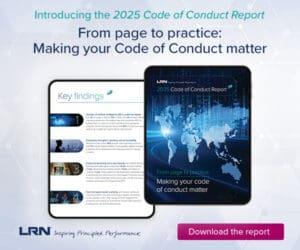Traditional tariff-washing — double invoicing, undeclared assists — has existed as long as tariffs themselves. But a newer risk is emerging around corporate disclosure: how and when companies publicly report on tariff impacts, mitigation strategies and financial effects in an environment where trade policies shift rapidly. Wayne Imrie of insurer Beazley examines the delicate balance compliance officers must strike, prioritizing transparency about decisions already made while resisting pressure to comment prematurely on uncertain impacts, recognizing that today’s statements will be scrutinized years from now when the market better understands tariff effects.
Tariffs have been long used by countries around the world as a bargaining tool with trade partners and to prop up domestic industry. In 2025, ongoing negotiations between the US government and its global trading partners have made tariffs a shifting target. A wide range of economic effects has impelled companies to adapt quickly and pivot frequently as duties are imposed and lifted. This landscape presents a challenging environment for boardrooms.
Organizations run the risk of tariff-washing in two ways. From a business operations point of view, how a company sources materials and products and how they declare them as they enter the country can present compliance difficulties. Common forms of this kind of tariff-washing include double invoicing to report a lower tariff charge or failure to declare “assists” when goods are produced in one country and finished in another, all practices that present a clear exposure for directors and officers. This kind of tariff-washing has been around for as long as tariffs themselves.
But there is a burgeoning risk centered around the disclosures companies are making about how the trade environment is affecting them operationally and financially. With tariffs currently in such flux, companies must consider when and how they publicly report on costs, demand, general inflation and the impact of tariffs on their business models. They also need to consider what and how they provide comments on mitigation strategies to address these effects.
As the market develops a better understanding of the impact of tariffs in a few years’ time, today’s public comment and disclosure will be held to a standard. Investors’ ability to see value will be in question as they weigh whether companies have downplayed or overplayed their hand on these issues.
How can organizations avoid the risk of tariff-washing?
Managing disclosure is difficult enough in “normal” times, but recent events — including the imposition of global tariffs and widespread protectionism, the increasing threat of cyber incursion and the implications of increasing AI use — have all made information disclosure trickier than ever. Tax policies, trade policies and agreements are shifting rapidly, and there are increasingly more questions as to what’s being applied, what caveats exist and the role of reciprocity. It can be challenging to simply keep up, let alone to decide how to handle disclosure.
Businesses can’t control everything, but they can control what they say. They can embed best practices on disclosure, including knowing how and when to comment on the potential costs from tariffs or the long-term implications of a cyber incursion or AI risk through a third-party provider.
As a best practice, organizations are well-advised to prioritize transparency about what they have done and how they are choosing to disclose. Most public companies are well-versed in how to handle this in their filings. It’s clear that disclosure is required if the impact is significant, but it’s also important to be transparent when talking about in-process plans and mitigation strategies. When effects are downplayed, or not addressed at all, organizations run the risk of being called to account for this failure at a later date.
How Boards Are Rewiring for Geopolitical Risk
From tabletop exercises to operational resilience assessments, the new toolkit for strategic oversight
Read moreDetailsOn the flip side, compliance officers should not feel compelled to comment when it’s not strictly necessary. Despite pressure from today’s 24/7 news cycle, in situations that do not require time-sensitive disclosure, organizations can and should pause and take a step back, run financial and operational impact modeling and make some decisions before issuing public statements. This information may very well need to be included in the next quarterly or annual filings, but there is not always a need to go out with disclosures sooner than that, regardless of reactionary news cycle pressure.
As a standard rule, sharing statements around potential effects is not always the best course of action; share prices move quickly due to negative investor sentiment. Immediate market reaction is not the only concern here. It’s important to remember that with AI, it is easy to track what CEOs have said over time and today’s plaintiffs’ bar regularly uses AI to build a case.
Compliance officers should take care to guard against future action by shareholders who look back at what was said in filings and analyst calls and take executives to task on their predictions.
Trade is a continually evolving situation for global businesses right now, and until a definitive decision is reached on where tariffs will be set for each country, organizations will be challenged to clarify what the impact of those tariffs will be to their products and services. Once those determinations have been made, companies can begin to respond in a compliant fashion, but they should not be continuously making disclosures until that time.
An exception to this would be if modeling suggests material impact on financial guidance that was previously released. Today’s global businesses need to be able to easily quantify their modeling and are obligated to share the impact and find ways to mitigate it. If it is determined that tariffs will have a material impact, the organization has a clear duty to disclose that information to investors, so that they are aware of what’s coming.
Tariff-washing is just the latest in a long line of disclosure challenges, including greenwashing and AI-washing, and ultimately, the risks and repercussions of saying too much or too little are similar for all. Silence is rarely an option. But unfortunately, it’s often the route taken.
Insurers and compliance officers should work together to communicate and disclose future risks in the best ways possible, limiting the chances of future legal action.




 Wayne Imrie is head of London market wholesale executive risks at insurer Beazley, where he is responsible for underwriting various management liability coverage lines, including directors & officers, employment practice liability, fiduciary, and wage & hour. He has over 25 years experience in the insurance industry, having held roles in broking, claims and underwriting.
Wayne Imrie is head of London market wholesale executive risks at insurer Beazley, where he is responsible for underwriting various management liability coverage lines, including directors & officers, employment practice liability, fiduciary, and wage & hour. He has over 25 years experience in the insurance industry, having held roles in broking, claims and underwriting. 




